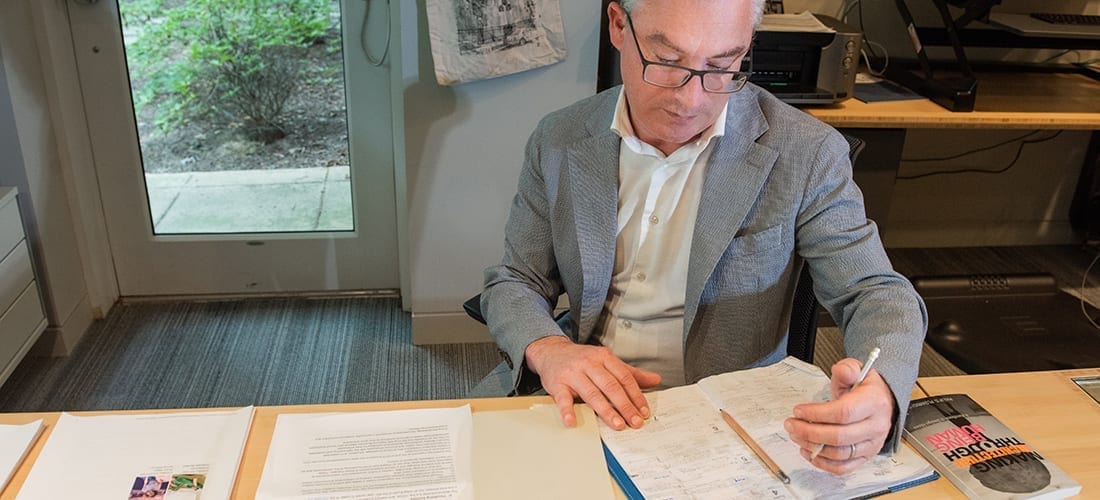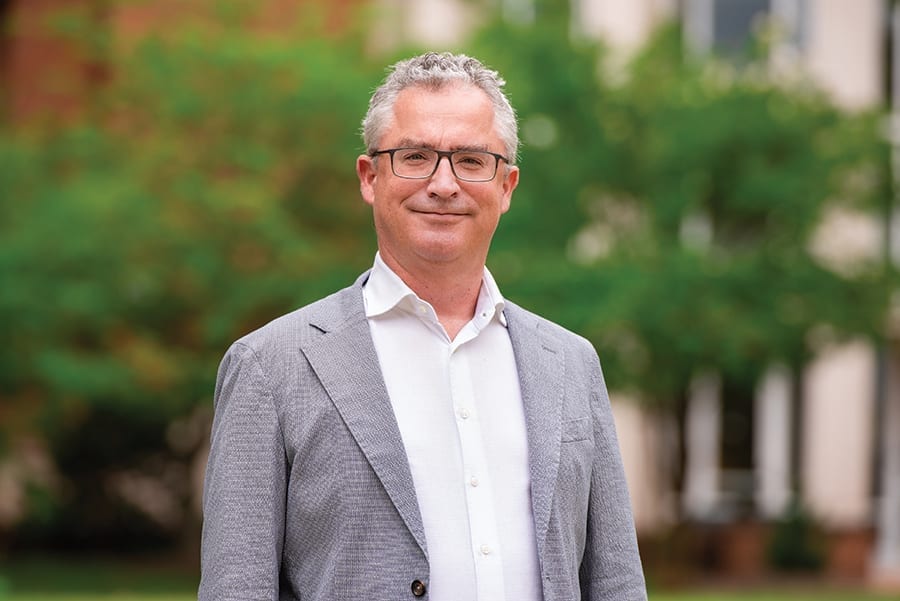Civic place-maker
September 1, 2020

Brook Muller, dean at UNC Charlotte College of Arts + Architecture, sees the arts as a vital element in shaping urban space.
by Michael J. Solender
While Brook Muller, the newly installed dean of the College of Arts + Architecture at UNC Charlotte, enjoyed a visit to Oregon earlier this spring, he was eager to return to his new home in the Queen City. “There’s so much to catch up with as we come back to school for the fall.”
Muller is a man in motion, rapidly taking to his new city and role since joining the college last fall. He doesn’t own a car: In fact, his walking commute to his office at the University of Oregon, his employer for 15 years, was more than 4 miles one way. There, he was a professor in the department of architecture and director of the university’s Portland Architecture Program. He began his professional career with Behnisch and Partners Architects in Stuttgart, Germany.
“Brook has the right emotional intelligence for this role,” says Ken Lambla, Muller’s predecessor as dean at the College of Arts + Architecture. “He’s one of the best listeners I know. He has a multidisciplinary background at Oregon and experience connecting not just with the community but [with] other sectors within his institution. He’ll use that as a springboard for connections and accomplishing things here.”
Water is an obsession for Muller — his name is Brook, after all. His extensive research in water infrastructure in the built environment includes work with biologists, ecologists, engineers and artists in developing systems for clean water all over the globe. Muller is currently focusing on a historic preservation effort in the El-Khalifa neighborhood of Cairo, Egypt, restoring 12th and 13th century domes. Water from leaky pipes is flooding the domes, and Muller is working with a team to divert and pump the water to an adjacent park. There, the newly irrigated plant life helps create shade for the neighborhood, something highly valued yet short in supply.
SouthPark spoke with Muller about the impact of art on urban design, a new graduate program in civic practice/community engaged arts, and the city’s green space as a defining feature.
Comments were lightly edited for length and clarity.

Why is this the right role for you at this stage in
your career?
The constellation of the disciplines within the college was extremely attractive to me, with performing arts, music, theater, dance, art and art history, and then the school of architecture. Every step in the process made me realize that this would be a great place to land. I’m thrilled to be here.
Why does UNC Charlotte combine disparate disciplines (art and architecture) in the same college?
It is an unusual combination. I’m greatly interested in civic placemaking. I believe with the future of Charlotte — questions of rapid urbanization and lack of affordability, gentrification, homelessness, climate-change impacts — the role of the artist is incredibly important.
It’s significant that when this tragic event took place last April 30th (the UNC Charlotte shooting and the death of two students), the university immediately looked to the arts to try to find meaning in this horrific and tragic event. It makes you realize when we’re experiencing a crisis, like the [pandemic] we are experiencing right now, the arts have incredible meaning and can offer perspectives that help us think through what we’re experiencing.
One of the goals for the college is developing a new graduate program unique to the Southeast — an MFA in civic practice and community engaged arts. What type of work would these graduates do?
We [see the program] as a way of putting the artist as a protagonist in a set of conversations about the future of the city. If we’re thinking about the [CATS light rail] Silver Line as one example, can we think of this as this opportunity to really think through opportunities for civic place-making and some of the problems related to affordability, gentrification, etc.? Artists have unique perspectives to lend to these kinds of conversations.
As an architect and urbanist, what physical features impress you most about Charlotte?
My wife is a landscape architect, and we go on walks. What’s impressive is Charlotte’s green infrastructure, the canopy and the creeks. I think those are monuments. We could also talk about the art institutions uptown, which are extraordinary, [and] the absolutely amazing set of cultural resources in the city. But I always start with the landscape. It’s this extraordinarily beautiful landscape, and the idea that people are looking at corridor connectivity and making recreational trails and making a regional infrastructure for enjoying this landscape means a lot to me. SP